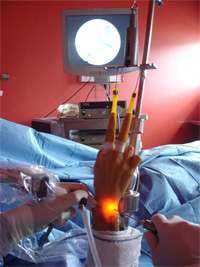Arthroscopy of the wrist
Arthroscopy of the wrist is indicated for serious wrist sprains, for a precise treatment of the joint fractures of the radius or the scaphoïd, in some forms of the initial stages of arthrosis of the wrist, ...
Arthroscopy is a technique using a camera and miniature instruments that are inserted into the wrist via orifices of a few millimetres (usually 2 to 4 mm).
The surgeon is then able to explore all of the anatomical elements situated within the joint using the camera and a video screen. This technique provides a tool for the precise diagnosis of the various lesions of the joint and also enables the surgeon to treat some of these lesions.
It is a relatively recent technique which appeared in the early 1990’s.
Indication
Arthroscopy of the wrist is indicated for serious wrist sprains (lesions of the ligaments between the small bones of the wrist), for a precise treatment of the joint fractures of the radius or the scaphoïd, in some forms of the initial stages of arthrosis of the wrist, ablation of a synovial cyst, and where there is a doubt as to the diagnosis of chronic wrist pain which remains unexplained by the usual examinations.
Surgical procedure

- Length of hospital stay: outpatient (no overnight stay)
- Anaesthetic: regional (only the arm is put to sleep)
- Immobilisation: arm in a sling for 2 to 4 weeks
The wrist is held in vertical traction for the procedure by means of a tower pulling on the fingers.
In general, **2 to 4 small incisions ** of a few millimetres are made on the back of the wrist to allow for the passage of the camera and instruments. For example the optic components connected to the camera measure from 1.9 to 2.7 mm in diameter.
Several instruments may be used such as hook, burr, motorised tightening apparatus, thermo-vaporiser, miniature suturing system. Apart from the precise exploration of the cartilage, the ligaments and the mobility of the various bones in relation to each other, this technique enables us to treat some types of lesions.
- In cases with rupture of the ligaments, the unstable fragments of the ligament will be removed and the distended parts of the ligament tightened via a thermal effect by means of a micro burning process.
- In cases with fracture or the after-effects of fracture, fragments of bone or fractured cartilage may be replaced and fixed. Zones of friction in cases of evolutive arthrosis can be abraded.
- In cases involving disinsertion of the trianguar ligament, the latter may be sutured with arthroscopic control.
- In cases with fracture of the scaphoïd, any binding or screwing of the fracture can be perfectly controlled with this technique.
- A synovial cyst can be completely removed from the inside of the joint.
Interests of the technique
Arthroscopy has provided us with an **understanding of formerly unknown lesions **, and the ability to treat lesions which in the past remained inaccessible. Now they can be treated surgically in good conditions.
Compared with open surgery procedures, arthroscopy results in simpler after operation care with a more rapid recovery of function, reduced pain and minimal scarring.
Complications
**Complications are rare **, but always possible.
- Algoneurodystrophy may develop, as with all operations and is manifested by a swollen, stiff wrist developing over several months or even years. It is not possible to predict its occurrence or the stiffness left as an after effect and pain is therefore a possibility.
- A small cyst may form at the scarring stage, but generally disappears after a few weeks.
- Ruptures of the tendons, infection, tingling sensations at the lesions of the nerve bundles are rare, but may occur. However, the main complication remains the fact that in cases with extensive intra joint lesions, arthroscopy does not systematically lead to a complete improvement in pain and functional discomfort.
Conclusion
The technique is a very useful one which allows us to diagnose and treat lesions which before remained inaccessible. In certain cases it can replace or delay classic open surgery techniques which constitute much more of a handicap.
The practice of this technique is reserved to experienced hand surgeons who are well used to the procedure.